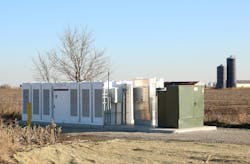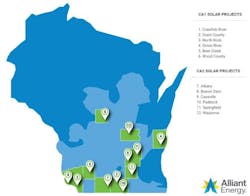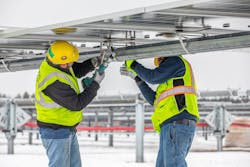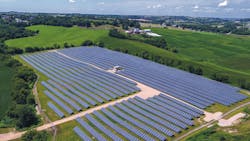When it comes to the environment, utilities take great pride in acting today to continually meet customers’ energy needs while also focusing on changing the way they generate energy. In fact, many are leveraging natural resources — the sun and wind — while moving away from fossil fuels to create a healthier environment.
In a 2021 Solar Market Insight report published by the Solar Energy Industries Association, the U.S. solar market installed a record 23.6 GWdc of solar capacity in 2021 — a 19% increase over 2020. According to the report, solar accounted for 46% of all new electricity-generating capacity added in the U.S. in 2021. It was the third year in a row solar made up the largest share of new generating capacity in the U.S.
In Wisconsin and Iowa, Alliant Energy is accelerating its transition to a clean energy future, outlining its plans in the Clean Energy Blueprint. While the utility focuses on advancing its transition to renewables and environmental compliance, it also is committed to integrating sustainability into its strategy and daily operations. The utility measures performance by improvements in its environmental, social and governance (ESG) corporate scorecard metrics and reports the results in its corporate responsibility report.
In the long run, its ESG commitment, coupled with its transition to solar and other renewables (such as wind) and new technologies (like battery storage), is a win for customers and communities across Iowa and Wisconsin.
Generation Transition
Alliant Energy’s Clean Energy Blueprint increases its use of renewable resources and directs the future of its coal-fired generation. “Our plan enhances the economic and environmental health of communities,” said Ben Lipari, director of resource development at Alliant Energy. “Along with contributing to a healthy environment, adding renewables creates jobs, provides lease payments to landowners and attracts new businesses to communities. It also is a smart investment. Providing renewable energy is more cost effective than upgrading or continuing to maintain and operate traditional energy sources like coal.”
Accelerating its transition also leads to billions in avoided long-term costs, helping to keep rates affordable. It also serves as an economic catalyst for local communities, generating jobs and local revenues.
In Wisconsin, construction is underway at several of the utility’s 12 solar projects. When operational, by the end of 2023, nearly 1100 MW of new solar will generate renewable energy.
In Iowa, Alliant Energy plans to add 400 MW of solar by the end of 2024, announcing its intent for the first 200 MW to come from the Duane Arnold solar project in Linn County. This project will repurpose a portion of the land and infrastructure at the former Duane Arnold energy center, a nuclear generating facility. The project is poised to use the site’s existing transmission infrastructure, which will help to minimize transmission and interconnection costs as well as mitigate upgrades to the transmission system.
Along with its large-scale solar projects, Alliant Energy is working to make solar energy accessible to everyone, including bringing solar to local businesses and communities. The utility has partnerships with several businesses and communities who host solar gardens. In addition, Fond du Lac, Wisconsin, is home to the utility’s first community solar project, which began producing power in January 2022. Collectively, these programs bring together customers and businesses who share a common interest in powering their community with solar energy.
Eliminations And Reductions
Besides adding renewable energy, Alliant Energy also is eliminating coal and reducing carbon dioxide emissions. Guided by its purpose-driven strategy, which centers on supporting customers and building stronger communities, the utility has its sights set on net-zero carbon dioxide emissions by 2050 for the electricity it generates.
Alliant Energy also has committed to replacing its light-duty vehicles with electric vehicles (EVs) by 2030. To help advance EV growth and ease infrastructure concerns, Alliant Energy recently joined the National Electric Highway Coalition. This collaboration aims to reassure customers they will be able to charge EVs no matter where they are driving.
The utility also plans to eliminate all coal from its generation fleet by 2040, and it is well on its way. In Iowa, the utility has transitioned its Burlington Generating Station from coal to natural gas, and it is working toward retiring its Lansing Generating Station by the end of 2022.
In Wisconsin, as more renewable resources are being brought on-line, Alliant Energy has also announced plans to retire the last of its coal generating facilities.
The utility also recently placed the West Riverside Energy Center into operation. Located near Beloit, Wisconsin, the highly efficient combined-cycle natural gas facility features two GE 7F.05 natural gas turbines and a GE D602 steam turbine as well as several energy-efficiency strategies. By using variable-speed driven motors, lighting optimization and an on-site integrated solar facility, West Riverside Energy Center’s auxiliary energy consumption is nearly 75% more efficient than the industry standard.
While producing enough energy to power more than 550,000 homes, the West Riverside facility emits about one-half the carbon dioxide generated by traditional coal-fired facilities. It also generates about two-thirds less nitrogen and 99% less sulfur and mercury.
The addition of solar across its footprint complements Alliant Energy’s commitment to wind energy. The utility owns and operates nearly 1800 MW of wind throughout its service territory. This includes more than 1300 MW in Iowa, enough to power over 500,000 homes.
Battery Storage Complement
As more renewables are planned for and placed into operation, the electric grid must continue to evolve to ensure ongoing energy reliability, efficiency and cost effectiveness. This includes integrating emerging and innovative technologies that can optimize energy resources and generation, such as battery storage.
In fact, expansion of energy storage, such as battery storage infrastructure, is key to accelerating the transition to cleaner and more sustainable renewable energy. When used in conjunction with solar generation, large-scale batteries can store energy generated by the sun and release it, as needed.
“Advances in battery storage technology are helping to maximize the benefits of renewable energy development and create new jobs in the communities we serve,” said David de Leon, president of Alliant Energy’s Wisconsin energy company. “Battery storage will ensure we continue to deliver safe, clean and reliable energy to our customers as we grow our renewable energy portfolio.”
The utility already has announced plans to add 75 MW of battery energy storage as part of its Duane Arnold solar project and expects to make an announcement soon in Wisconsin. The utility also is preparing to launch up to 100 MW of total distributed energy resources, such as energy storage systems and community solar, in Iowa.
At the same time, the utility is piloting several smaller battery projects to better understand how expanded energy storage can help to increase the efficiency of capturing and storing energy generated by the sun and wind.
“As technology continues to improve, we look to learn more about the ways battery storage solutions can deliver enhanced efficiency, reliability and affordability for our customers,” de Leon added. “These smart investments in innovative energy solutions will transform our energy grid and create countless new opportunities.”
In March 2022, Alliant Energy announced the completion of its latest energy storage pilot project: a 5-MW, 10-MWh lithium-iron- phosphate (LFP) battery in Portage, Wisconsin, designed to participate in the Midcontinent Independent System Operator (MISO) ancillary market and improve customer affordability. Recognizing the importance of resiliency and the harsh reality of Midwest winters, this battery system is engineered to operate safely for more than 20 years and function in temperatures down to -22°F (-30°C).
Battery storage technology also is the central component in a community-scale microgrid project being constructed in Boaz, Wisconsin. This pilot project uses a 400-kW/3200-kWh LFP battery to create a small-scale power grid with islanding capability for the 156-person community located in the southwest corner of the state.
The rural village is currently served by a single overhead distribution line, which has resulted in several outages and service disruptions over the past three years. The US$3 million microgrid pilot project will deliver improved reliability for customers in Boaz while avoiding the expensive alternative of undergrounding several miles of distribution lines.
Once fully constructed and operational, by the end of 2022, the microgrid will enable the community of Boaz to disconnect from the traditional grid and operate independently in the event of a power outage or service disruption. In other words, the system will automatically switch to the microgrid when an issue arises, so the community continues to have power. Once the issue is resolved, the community will be transferred back seamlessly to the grid.
In addition to serving as energy storage resources, Alliant Energy plans to capitalize on research and development opportunities at each of its battery sites by closely studying system performance metrics and design features.
Each energy storage pilot system in place serves a unique purpose. The reasons vary from stabilizing voltage with high photovoltaic penetration to improving service to remote customers and relieving peak demand load on circuits to avoid more costly infrastructure upgrades.
Full Speed Ahead
The utility believes learnings from its pilot projects, coupled with the integration of emerging battery technologies, will help to create improved energy reliability, security and cost effectiveness. As Alliant Energy accelerates its transition to renewable energy and develops nearly 1500 MW of new solar energy in Iowa and Wisconsin, additional energy storage capacity will deliver increased reliability and long-term access to clean, locally generated electricity.
Battery- and utility-scale solar projects are just a few of the solutions Alliant Energy offers customers — residential, commercial, industrial and organizations — to achieve their own clean, renewable energy goals. These solutions include customer-hosted renewables, community solar, renewable energy partner, customer-owned renewables and a second nature program.
Barbara Tormaschy is senior vice president of sustainability and regulatory strategy at Alliant Energy Corp. In this role, Tormaschy has oversight of the utility’s environmental, social and governance (ESG) programs, sustainability, resource development, and regulatory strategy and solutions teams. She joined the utility in 2016 as vice president of finance and was named treasurer in 2019. Tormaschy is passionate about helping others. She is the president and finance committee member for The Road Home Dane County, which works to ensure every child in the community has a home.
Company Listings
GE | www.ge.com
About the Author
Barbara Tormaschy
Barbara Tormaschy is senior vice president of sustainability and regulatory strategy at Alliant Energy Corp. In this role, Tormaschy has oversight of the utility’s environmental, social and governance (ESG) programs, sustainability, resource development, and regulatory strategy and solutions teams. She joined the utility in 2016 as vice president of finance and was named treasurer in 2019. Tormaschy is passionate about helping others. She is the president and finance committee member for The Road Home Dane County, which works to ensure every child in the community has a home.






